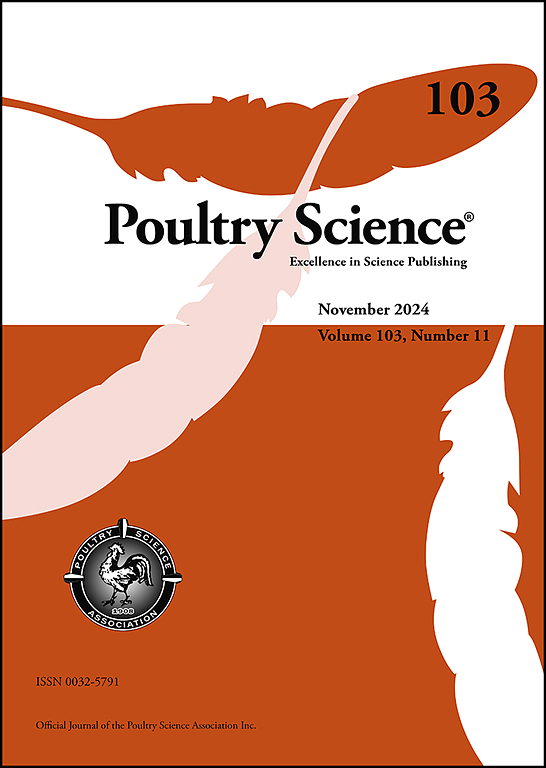孵化蛋储存时间和从储存到孵化温度的升温速率对形态肉鸡胚胎发育的影响
IF 4.2
1区 农林科学
Q1 AGRICULTURE, DAIRY & ANIMAL SCIENCE
引用次数: 0
摘要
孵化蛋贮藏影响肉鸡胚胎的发育和存活。贮藏时间超过7 d,孵化率降低,孵化延迟,日龄雏鸡质量下降。这些负面影响可以通过鸡蛋从储存温度(18°C)加热到孵化温度(37.8°C)的速度来减轻,这被称为“升温速度”。本试验研究了保温时间与升温速率互作对肉鸡蛋形态胚发育和存活的影响,以及对蛋清和蛋黄pH值的影响。采用2 × 3因子试验,试验了2种贮藏时间(4和14 d)和3种升温速率(10、24和144 h)。在贮藏14 d期间,胚胎在形态上有所进步,但在升温和孵育期间,这些胚胎与贮藏4 d的胚胎相比落后。这可能是由于贮藏14 d后蛋白和蛋黄pH值差异较大,这可能解释了孵出的小鸡与贮藏4 d相比较矮(19.5厘米对19.6厘米;P = 0.04)。24 h和144 h的升温速率允许胚胎在达到孵育温度之前发育,而不影响孵育期间的生长。144小时的升温速率导致雏鸡在孵化时更长(19.6厘米vs 19.5厘米;P = 0.04),潜伏期较短(77 h;P & lt;0.01),而升温速率为10 h。保温4 d后,孵育率由保温10 h时的93.6%提高到保温144 h时的96.0% (P = 0.04)。贮藏14 d后,不同升温速率下的孵化率基本一致。然而,保温10 h和24 h的孵育时间比4 d的孵育时间(分别为2和9 h)有所增加;P & lt;0.01),但对144 h升温速率没有影响。没有孵化延迟表明,144小时的升温速率可能补偿了通常与14天蛋储存相关的发育延迟。本文章由计算机程序翻译,如有差异,请以英文原文为准。
Effects of hatching egg storage duration and warming rate from storage to incubation temperature on morphological broiler embryo development
Hatching egg storage affects the development and survival of broiler embryos. Storage for longer than 7 d is associated with decreased hatchability, delayed hatching, and lower day-old chick quality. These negative effects may be mitigated by the rate at which eggs are warmed from storage temperature (18°C) to incubation temperature (37.8°C), which is referred to as the ‘warming rate’. The current study investigated effects of broiler egg storage duration in interaction with warming rate on morphological embryo development and survival, and how albumen and yolk pH are affected. An experiment with a 2 × 3 factorial arrangement, testing 2 storage durations (4 and 14 d) and 3 warming rates (10, 24, and 144 h), was conducted. During 14 d of storage, embryos advanced morphologically, but during warming and incubation, these embryos lagged behind compared to those stored for 4 d. This might be due to the larger difference between albumen and yolk pH after 14 d of storage, potentially explaining the shorter chicks at hatch compared to a 4 d of storage (19.5 vs 19.6 cm; P = 0.04). A 24 h and 144 h warming rate allowed the embryo time to develop before reaching incubation temperature, without affecting growth during incubation. A 144 h warming rate resulted in longer chicks at hatch (19.6 vs 19.5 cm; P = 0.04) and a shorter incubation duration (77 h; P < 0.01), compared to a 10 h warming rate. After 4 d of storage, hatchability increased from 93.6 % for the 10 h warming rate to 96.0 % following a 144 h warming rate (P = 0.04). After 14 d of storage, hatchability was similar for all warming rates. Incubation duration, however, increased for the 10 h and 24 h warming rate compared to 4 d of storage (2 and 9 h respectively; P < 0.01), but not for the 144 h warming rate. The absence of a hatch delay suggests that a warming rate of 144 h may have compensated for the developmental delay typically associated with 14 d of egg storage.
求助全文
通过发布文献求助,成功后即可免费获取论文全文。
去求助
来源期刊

Poultry Science
农林科学-奶制品与动物科学
CiteScore
7.60
自引率
15.90%
发文量
0
审稿时长
94 days
期刊介绍:
First self-published in 1921, Poultry Science is an internationally renowned monthly journal, known as the authoritative source for a broad range of poultry information and high-caliber research. The journal plays a pivotal role in the dissemination of preeminent poultry-related knowledge across all disciplines. As of January 2020, Poultry Science will become an Open Access journal with no subscription charges, meaning authors who publish here can make their research immediately, permanently, and freely accessible worldwide while retaining copyright to their work. Papers submitted for publication after October 1, 2019 will be published as Open Access papers.
An international journal, Poultry Science publishes original papers, research notes, symposium papers, and reviews of basic science as applied to poultry. This authoritative source of poultry information is consistently ranked by ISI Impact Factor as one of the top 10 agriculture, dairy and animal science journals to deliver high-caliber research. Currently it is the highest-ranked (by Impact Factor and Eigenfactor) journal dedicated to publishing poultry research. Subject areas include breeding, genetics, education, production, management, environment, health, behavior, welfare, immunology, molecular biology, metabolism, nutrition, physiology, reproduction, processing, and products.
 求助内容:
求助内容: 应助结果提醒方式:
应助结果提醒方式:


